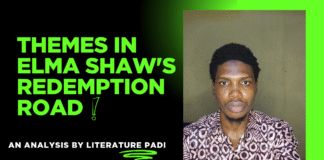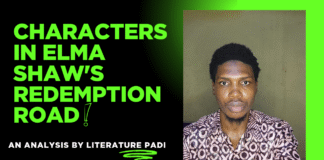🎥 We’re cooking something delicious for you on our YouTube channel. In the coming days, you will learn SSCE literature texts like you're in class 📚✍🏽
Be part of this new journey we are about to embark on.
🔔 Subscribe Now
“Argument with God” by Henry Barlow is a poem that tells the story of a parent who is deeply worried because his child is fighting for life in the hospital. The speaker turns to God in silent prayer, hoping for help — but God doesn’t respond. This silence makes the speaker feel even more scared, angry, and confused.
The speaker tries everything — begging, promising to be a better person, and asking for justice. He just wants his child to live and be free from pain. But still, there’s no answer from God.
Then, something unexpected happens. While still praying, the speaker sees a cockroach on the wall, struggling to give birth. Without thinking, he kills it. He snuffs out a life as he prays for another. This disturbing contradiction is the poem’s climax and moral twist. It mirrors the very injustice he accuses God of.
“Argument with God” was written by a Ugandan poet and writer, Christopher Henry Muwanga Barlow, in 1967. The poem is published as one of the poems in his year 2000 poetry collection, Building the nation and other poems. The poem deals with the themes of suffering, divine silence, the human need for justice, and the moral contradictions that exist in human nature.

Structure of “Argument with God”
“Argument with God” is a fifty-line poem divided into seven uneven stanzas. The poem is written in free verse. Its structure mirrors the speaker’s emotional turbulence and the unstructured nature of human grief. Here is an outline of the number of lines each stanza has:
- Stanza 1 has four lines.
- Stanza 2 has seven lines.
- Stanza 3 has eleven lines.
- Stanza 4 has six lines.
- Stanza 5 has nine lines.
- Stanza 6 has eleven lines.
- Stanza 7 has two lines.
The entire poem reads like a dramatic monologue or interior dialogue, where the speaker addresses God in a one-sided conversation.
Stanza-by-Stanza Analysis of “Argument with God”
Stanza 1 (Lines 1–4)
In the first stanza, the speaker introduces the emotional context of the poem. His child is critically ill in the hospital, and he is overwhelmed with worry, exhaustion, and fear.
In response, he turns to silent prayer, but this silence is not peaceful — it is filled with internal turmoil and frustration, as he silently argues with God. The phrase “violent silence” captures the tension between outward calm and inner anguish; it sets the tone for the spiritual conflict that follows.
Stanza 2 (Lines 5–11)
The speaker begins to question God directly. He asks Him why his child must suffer continuously. His repeated “Why?” shows his desperation and inability to understand the situation.
However, God remains silent; He offers no comfort, answer, or sign. This deepens the speaker’s frustration and spiritual confusion, and the prevailing crisis of faith in the poem.
Stanza 3 (Lines 12–22)
Feeling ignored, the speaker turns inward. He wonders if God’s silence is a punishment for his own sins. He decides to bargain with God by promising to become a better man if only his child can be spared pain and death.
This stanza captures a very human response — trying to make a deal with a higher power in a moment of helplessness.
Stanza 4 (Lines 23–28)
The speaker plays the emotional appeal card. He portrays his deep love for his child and pleads for understanding and mercy. His repetition of “Don’t you, don’t you, DON’T YOU?” shows rising intensity and desperation.
Still, God remains “dumb” (silent), and the speaker painfully compares this to his own child’s voiceless, suffering state. His comparison draws a haunting parallel between divine silence and the child’s condition.
Stanza 5 (Lines 29–37)
The desperate father of the ailing child, in his desperation for a response, chooses to appeal to God’s justice. He believes that even if God remains silent, He must still be fair. The speaker argues for his child’s right to live, trusting that divine justice would not allow such suffering to continue.
There’s a clear shift here from pleading with God to reasoning with Him.
Stanza 6 (Lines 38–48)
At the moment the speaker prays for life and justice, he notices a pregnant cockroach in labour, struggling to give birth. Instead of showing mercy, he instinctively kills it without hesitation: “I snatched a newspaper, / And hit the cockroach…”.
This action becomes a powerful symbol of human hypocrisy and the contradictions in human morality. The irony is stark and deliberate. The speaker demands life and fairness from God while denying life to another helpless creature. He wants his ailing child to live but deliberately kills a cockroach and its offspring: “I crushed it, / With the heel of my shoe”. He blames God for being unfair, yet his own action does not convey fairness.
Stanza 7 (Lines 49–50)
“Argument with God” closes with a haunting line: “All the time I was praying, / Violently pleading for life.” This ties everything together. While the speaker passionately prays for his child’s life, he simultaneously takes the life of another being. The final lines underline the central irony of the poem — a man pleading for mercy, yet acting without it.

Mood and Tone of the Poem
Mood
From the start, the mood is one of deep anxiety, rooted in the fear of losing a child. The speaker’s tone is jittery, sleepless, and on edge: “I, worried tense and tired, / Sat in silent prayer”. As God remains silent, the mood turns to hopelessness and frustration. The speaker’s internal conflict intensifies, and we feel his rising desperation.
The killing of the cockroach, juxtaposed with the prayer for life, introduces a disturbing and morally unsettling mood. The reader is left with a feeling of discomfort and reflection.
Tone
The tone is intensely personal, almost confessional. The speaker holds nothing back — he questions God, admits his flaws, and wrestles with divine silence. At points, especially when he repeats “Don’t you, don’t you, DON’T YOU?”, the tone becomes accusatory. He is not just asking — he is challenging God’s justice and mercy.
In the final stanza, the tone shifts to something more reflective and self-exposing. The irony of his action dawns subtly.
Figures of Speech in “Argument with God”
1. Irony
Irony is when the opposite of what is expected occurs. The entire poem is laced with situational irony, especially in the ending. The speaker kills a struggling pregnant cockroach while praying for his child’s life. He becomes the very figure of arbitrary judgment and silence he accuses God of being.
2. Personification
Personification gives human qualities to non-human entities.
“God was silent!
Not a word from him”
God is depicted as someone capable of speech and deliberate silence. God is at best a non-human entity given human attributes in this poem.
“God was dumb.
Dumb, like my child.”
God is personified as “dumb” (silent) in what is a painful parallel of the helplessness of the child. Simile is also instantiated in this example.
3. Apostrophe
Apostrophe is a direct address to an absent, dead, or non-human entity as if it were present and capable of responding.
The entire poem is an apostrophe directed at God:
"God, I said,"
"God, I pleaded,"
"God, I continued,"
"God, I called,"
The speaker speaks directly to God in a desperate attempt to be heard.
4. Oxymoron
Oxymoron is a figure of speech that combines two words or phrases that seem contradictory. An example of oxymoron in the poem is “violence silence”. The phrase captures the inner turmoil and suppressed anguish of the speaker. The argument with God is not verbal but emotional and spiritual.
5. Symbolism
Symbols are objects, characters, or actions that represent larger ideas.
In the poem, “the cockroach” symbolises life in its most vulnerable form. It is a signification that even a “lowly” creature deserves to live. It mirrors the child’s own fragile condition, and is reflective of Man—God relationship and power dynamics.
“Newspaper” and “heel of the shoe” represent human power and judgment, used thoughtlessly and destructively — a parallel to divine power as perceived by the speaker.
6. Repetition
Repetition is a literary device where words, phrases, or even whole lines are deliberately repeated to create emphasis, rhythm, or emotional intensity.
You know how I love him don’t you?
Don’t you, don’t you, DON’T YOU?
“Don’t you” is repeatedly used in lines 24 and 25. The repetition and escalation in capitalisation portray the speaker’s emotional breakdown and deep need for divine empathy. The emphatic lines can also pass for rhetorical question.
“Not a word from him,
Not a word.”
The repetition in lines 10 to 11 underscores the excruciating silence and perceived abandonment by God.
7. Alliteration
Alliteration is the repetition of initial consonant sounds. An example of alliteration in the poem is “sat in silent prayer” (l. 3). These soft, sibilant sounds mimick the quietness of hospital vigil and internal struggle.
8. Juxtaposition
Juxtaposition places two contrasting ideas side by side to highlight differences. The poem sets the stage for the child’s struggle versus the cockroach’s struggle. It juxtaposes human and insect suffering to reveal shared vulnerability and expose moral contradiction.
9. Imagery
Imagery appeals to the senses and creates vivid mental pictures.
“It fell on its back,
Struggling for life,
And I crushed it,
With the heel of my shoe.”
The above lines, which demonstrate the use of visual and tactile imagery, create a stark, disturbing picture of death.
10. Rhetorical Question
A rhetorical question is a question that is asked for effect, not meant to be answered. Instances of rhetorical question in the poem are:
“Why do you allow him to suffer so?”
“Why him all the time?”
“Why?”
These three questions express the speaker’s confusion, frustration, and emotional pain over his child’s suffering. He isn’t expecting answers. He’s venting his heartbreak and helplessness.
“You know how I love him don’t you?”
“Don’t you, don’t you, DON’T YOU?”
These questions show his desperate plea for divine empathy. He repeats them for emotional force, not because he expects God to reply.
Final Thoughts
“Argument with God” is a brutally honest poem that exposes the fragile line between faith and doubt, piety and hypocrisy. The poem poses questions it doesn’t answer: Are we truly consistent in our moral appeals? Can we demand justice without practicing it?
Related:
Receive Literary Updates through our Social Media Channels:
- WhatsApp: Literature PADI
- Telegram: Literature PADI
- YouTube: @literaturepadi
- Facebook: Literature PADI











